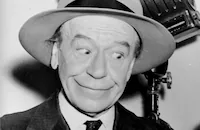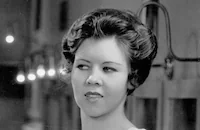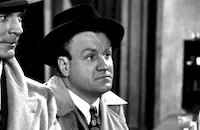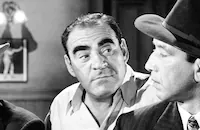They Got Me Covered
Brief Synopsis
Cast & Crew
David Butler
Bob Hope
Dorothy Lamour
Lenore Aubert
Otto Preminger
Edward Cianelli
Film Details
Technical Specs

Synopsis
Bumbling war correspondent and former Pulitzer Prize-winner Robert "Kit" Kittredge returns to America and is summarily fired by his boss, Norman Mason, when he fails to report that Germany has invaded Russia. Kit then visits his girlfriend, stenographer Christina Hill, where she works in the Washington, D. C. offices of his former newspaper chain. Their reunion is interrupted by Gregory Vanescu, one of Kit's sources, a Romanian who has come to give Kit a big scoop. Before Vanescu can tell his story, however, Nazi spies shoot at him and he flees, leaving a note instructing Kit to send Christina to the Lincoln Memorial at midnight with a red purse and green umbrella. Kit and Christina ask one of Christina's roommates, Sally Branch, to meet them at the memorial with the purse, umbrella and Christina's monogrammed notepad, but that night, Kit drives Christina to the Washington Monument by mistake. When Vanescu sees Sally, he assumes she is Christina and has her transcribe his information concerning German, Italian and Japanese spies who are headquartered in a Washington beauty shop and preparing to bomb the city. Just as Vanescu finishes, the Nazi agents attack and steal the notebook. Meanwhile, Kit, Christina, her three other roommates and Sally's Marine boyfriend, Red, wait for Sally at her apartment. When she finally returns, hysterical, the roommates give her a sedative before she can tell Kit what has happened to the notebook. Soon after, the spies discover that they cannot translate Sally's shorthand, and so sneak into her apartment and smuggle her out in a hamper. After Kit mistakenly helps the spies, Christina realizes what has happened and insists that he call the FBI, but Kit, anxious to get the story and win his job back, only pretends to do so. Instead, he notices the name of a nightclub on the note Vanescu wrote to him earlier and rushes there to investigate. At the club, a gypsy woman tells Kit to visit a private room upstairs in which, unknown to him, the spy Olga and her superior, Otto Fauscheim, lay in wait. In order to deflect Kit's attention from getting his story, Olga pretends to be Vanescu's wife, seduces Kit and claims to need his help locating her missing husband. She leads him to an old mansion, hoping an insane Civil War veteran living there will frighten him off, but Kit blithely confuses the man by playing along with his delusions, and soon after uncovers Vanescu's dead body. Olga then secretly consults Fauscheim, who decides to incapacitate Kit by ruining his reputation. Fauscheim then drugs Kit with a doped cigarette and has him marry a showgirl, Gloria the Glow Girl, while he is passed out. Although all the papers carry the story of Kit's marriage the next morning, Christina realizes that Kit must have been set up, and when he brings her a handkerchief he stole from Olga, she amasses her roommates, who work in various sectors of the government, to trace the perfume on it. Kit then visits Gloria, who agrees to reveal the Axis plan to her new husband and hands him a flower as a clue, but is stabbed by the spies before she can tell her story. Now suspected of the murder, Kit quickly escapes and searches the flower shop Gloria uses for more clues, but is captured by the lead Italian operative, Baldanacco. The next day, Christina discovers that Olga's perfume was purchased at a beauty salon which is owned by the same poeple who own the nightclub. She goes there, hoping to tie the owners to the spy ring, but when she asks for a massage, Olga, who runs the salon, finds her purse and realizes her name matches that on Sally's notebook. Olga then orders the burly masseuse to detain Christina, while in another room in the salon, the kidnapped Kit escapes from his bonds and, disguising himself as a mannequin, sneaks into the showroom in which the Axis contingent are meeting. After hearing their plans to blow up the city, Kit is discovered, but manages to fend off the spies until the roommates, Red and his Marine buddies arrive in search of Christina and barge into the showroom. The whole group subdues the spies, and as the police arrive, Kit kisses Christina while his friends discuss the likelihood of his winning another Pulitzer Prize.

Director
David Butler
Cast

Bob Hope

Dorothy Lamour

Lenore Aubert

Otto Preminger

Edward Cianelli

Marion Martin

Donald Meek
Phyllis Ruth
Philip Ahn

Donald Macbride

Mary Treen
Bettye Avery

Margaret Hayes
Mary Byrne
William Yetter
Henry Guttman

Florence Bates

Walter Catlett

John Abbott
Frank Sully
Joe Devlin
Greta Meyer
Wolfgang Zilzer
Nino Pipitone
Kam Tong
George Chandler
Stanley Clements
Don Brodie
Walter Soderling

Lyle Latell

Arnold Stang
Jack Mather
Hector Sarno
Joe Romantini
Margaret Fealy
Etta Mcdaniel
Ray Turner
Willie Fung

Ralph Dunn
Edward Gargan
Shimen Ruskin
Stanley Price
Carli Elinor
John Bleifer
Lou Lubin
Ferike Boros
Hugh Prosser
Donald Kerr
Pat Lane
Jack Carr
Bill O'leary
Peggy Lynn
Lillian Castle
Doris Day
Anne O'neal
Hans Schumm
Henry Victor
Davis Roberts
Victor Metzetti
Tom Metzetti
Gil Perkins
John Sinclair
George Sherwood
Lane Chandler
Dick Keane
Jack Gardner
Byron Shores
Charles Legneur
Crew
Adrian
Harold Arlen
C. Bakaleinikoff
Ray Binger
Howard Bristol
Mcclure Capps
Jack Crosby
Frank Fenton
Perry Ferguson
Samuel Goldwyn
Samuel Goldwyn
Leigh Harline
Don Hartman
Edith Head
Arthur Kober
Harry Kurnitz
Fred Lau
Ernie Laverne
Daniel Mandell
Rudolph Maté
Walter Mayo
Johnny Mercer
Lynn Root
Leonard Q. Ross
John Sherwood
Leonard Spigelgass
Collier Young

Film Details
Technical Specs

Articles
THE ROAD TO HONG KONG, THE FACTS OF LIFE and Other Comedies Are Featured in Bob Hope: MGM Movie Legends Collection
This is plainly visible in the sampling of his films on the DVD set Bob Hope: MGM Movie Legends Collection. Ranging over three decades, the films show Hope in full Hope mode whether he's rushing merrily through some trifling story or trying to heat up a script that somebody should have rethought. His film career started with several shorts in the mid-30s before moving to a few supporting spots and finally graduating to lead roles in 1938's Give Me a Sailor. (He gained a theme song in that February's The Big Broadcast of 1938 and then used it for a film title before the year was out: "Thanks for the Memory".) In 1940 he was teamed with Bing Crosby in Road to Singapore and Hope's place on the silver screen was assured. He consistently found time for a string of starring roles until 1972 and then settled into cameo appearances after that.
The earliest film here, 1943's They Got Me Covered, is also one of the best. Hope plays a hapless reporter in wartime Washington DC who blunders into a spy ring, dragging girlfriend Dorothy Lamour along with him. The film looks like it was shot quickly and has a charming disregard for reality: the Nazi spy base is an improbably large fashion salon and their safe house has--for no apparent reason--Donald Meek who believes he's protecting President Lincoln from the Confederates. But reality hardly matters. Hope is in fine form tossing off sharp gags and standing up to the spies when his first impulse is to flee in panic. Lamour matches him move for move and provides a solid foil for Hope's antics, not just a straight person to play against but a full and smarter partner.
Two more efforts toss Hope into genre films. The Princess and the Pirate (1944) imagines him as one of the world's worst touring actors accidentally captured by pirates and eventually rescuing disguised princess Virginia Mayo. In Alias Jesse James (1959), Hope is a New York insurance agent who unknowingly takes out a life policy on Jesse James and then has to head out West to be sure nothing happens to his client. Among the sagebrush, he gets tangled up with saloon girl Rhonda Fleming. You see the pattern of pairing him against beautiful leading ladies though neither Mayo nor Fleming are up to Lamour's standard, which could be due to the scripts. Both films are lively though Princess is clearly the funnier and more inventive of the two. Western fans will definitely want to see an inspired sequence at the end of Alias Jesse James that can't be revealed here without ruining the gag.
Moving into the 60s, studios seemed to have less idea of what to do with Hope. His comic approach never completely went out of style, just changed forms. Still, it was easy to see Hope as outdated when surrounded by the dissolving studio system, TV's challenges and the new breed of comics (Lenny Bruce, Nichols & May, Bob Newhart). Hope no longer fit into a clear position, something the later films in the set show. Boy, Did I Get a Wrong Number! (1966) imagines Hope as a bland, devoted family man who gets tangled up with Elke Sommer as a European sex kitten running away from the set of her latest film. Probably envisioned as a classic farce, this is really the type of film whose story would fall completely apart if Hope only revealed to his wife that Sommer was hiding in their cabin. Like many films of the period, it plays at being "naughty" or "free spirited" but is utterly conventional (even Hope's gags are more restrained). At least Phyllis Diller is on hand as an assertive housemaid to spark up the proceedings.
The same faux naughtiness can be seen in 1965's I'll Take Sweden where single father Hope packs teenaged daughter Tuesday Weld off to Sweden to keep her out of the hands of her layabout, quasi-beatnik boyfriend. It's an example of how far out of touch the film is that the layabout boyfriend is Frankie Avalon. There are a few halfhearted moves toward unmarried hankypanky and several jokes at the openness of Swedish romantic life as Sweden drifts among the same realm of supposedly free-spirted farce as Wrong Number. In the end nothing out of the ordinary happens unless you count Avalon's stop-the-story and never-campy-enough songs. The film does close with a classic door-slamming, in-and-out of room sequence but overall is pretty dreary despite the best efforts of Hope and Weld (but almost nobody else).
One highlight of these later years is the seventh and final "Road" film, Road to Hong Kong from 1962. Dorothy Lamour, co-star of the previous films, was replaced by Joan Collins, probably because Collins was two decades younger but also due to a British production company wanting to showcase their own talent. As it turns out, Collins didn't showcase impressively and Lamour's brief cameo appearance proves she was smarter, funnier and simply more attractive. Nevertheless, while Hong Kong is the weakest in the series (the spies and space travel plot was barely enough for a TV skit and has dated badly) it shows why Hope and Crosby were such a good team and doesn't completely deserve its reputation as a stumbling end to the series. The duo's gags come across as actual dialogue rather than bits of something the writers concocted and both create a feeling of relaxed humor that many more aggressive comics would do well to emulate (if they can). Peter Sellers appears as an Indian doctor in a small segment that's a mini-masterpiece of double-talk. The film does have a couple of misguided sequences (one involving a feeding maching in the space capsule is particularly humiliating) and some comments about Asia are a bit dubious today but overall Hope and Crosby still displayed enough charm that you almost wish they could have done one more film.
The anomaly here is 1960's The Facts of Life, Hope's attempt at a more-or-less straight dramatic role. There are still jokes-Hope wasn't about to leap into a void-but this time they come from his character and even bring out criticism from others. Most notably that's Lucille Ball as a friend's wife who can't stand the humorous commentary and good-fellow cheerfulness in a critique, however mild, of Hope's usual persona. During a group vacation to Mexico where most of the group gets waylaid, Hope and Ball follow the Hollywood rule that opposites attract and start an affair. Played mostly straight, The Facts of Life is fairly reliable melodrama with a smear of comedy (one sequence where Hope gets lost among identical motels is clever) but never quite pulls together. The big problem is that Hope either didn't have this type of acting in him or needed more firm guidance from the director. Ball on the other hand is completely plausible as a lonely wife, almost single-handedly keeping the film from feeling by-the-book. Viewed today it's odd to think this gathered five Oscar® nominations, winning one for best black-and-white costume design.
Bob Hope: MGM Movie Legends Collection has each film on a separate disc in a slim clase. There are no extras beyond trailers though a couple of the later films have a choice of full-screen or letterboxed (but none are fully widescreen). The transfers are solid though there are a few moments in The Princess and the Pirate where it appears as if the Technicolor strips were briefly out of registration. Nothing major and a lot of viewers won't even notice. The set On The Road With Bob Hope And Bing Crosby which collects the first four "Road" films is still the best place to see Hope in action but this is a good if uneven follow-up.
For more information about Bob Hope: MGM Movie Legends Collection, visit MGM. To order Bob Hope: The MGM Movie Legends Collection, go to TCM Shopping.
by Lang Thompson

THE ROAD TO HONG KONG, THE FACTS OF LIFE and Other Comedies Are Featured in Bob Hope: MGM Movie Legends Collection
Quotes
Trivia
Notes
The working titles of this film were Washington Story and The Washington Angle. Although Hollywood Reporter news items mention that Arthur Kober collaborated on the original script and Don Hartman, producer Samuel Goldwyn's writer and production assistant, worked on uncompleted scenes, the contributions of these writers cannot be confirmed. Although Hollywood Reporter news items list Gladys Blake, Harry C. Bradley, Roma Aldrich and James Seay as cast members, they were not in the released film. Early Hollywood Reporter items state that Byron Foulger would play the part of "Norman Mason" and that Sam Hayes was cast as a radio announcer, but neither appears in the final film. Dorothy Lamour was borrowed from Paramount, and Marion Martin from RKO, for this film.
Star Bob Hope was on loan to Goldwyn from Paramount for the first of two films, in exchange for Gary Cooper's appearance in 1942's Star-Spangled Rhythm, a film in which Hope also appeared. Goldwyn capitalized on Hope's popularity on radio and in films by taking the picture's release title from the title of Hope's best-selling autobiography, although none of the material from the book was used.
As noted in a July 1943 Hollywood Reporter article, "Goldwyn goes right to the front page for They Got Me Covered when he lifts the story of the Nazi sub saboteurs and plants it in the picture as part of an espionage plotline." The film was also one of the first Hollywood pictures to be affected by the War Production Board's order for the studios to limit costs, and, as a February 1943 New York Times story noted, this resulted in some scenes being filmed in an abandoned Los Angeles gas works factory instead of in the studio. As filming wrapped, in September 1942, Goldwyn awaited permission from Washington to end the film by portraying Axis powers being apprehended before December 7, 1941, the date of the Pearl Harbor attack. The end was approved, and according to a September 1942 Hollywood Reporter article, one of the few requests for changes came from the embassy of neutral Turkey, who asked that the name of the Axis spies's nightclub be changed from Café Instanbul to Café Moresque to avoid any connection to their country.

Miscellaneous Notes
Released in United States 1943
Released in USA on video.
Released in United States 1943













